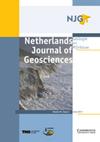Ryazanian (Berriasian) molluscs and biostratigraphy of the Dutch and Norwegian North Sea area (south of Viking Graben)
IF 2.3
2区 地球科学
Q3 GEOSCIENCES, MULTIDISCIPLINARY
Netherlands Journal of Geosciences-Geologie En Mijnbouw
Pub Date : 2022-04-28
DOI:10.1017/njg.2022.5
引用次数: 1
Abstract
Herein, Ryazanian (Berriasian) macrofossils from three well cores in the Central Graben (wells B18-02, L06-02, The Netherlands) and on the Jæren High (well 7/7-2, Norway) in the southern North Sea region are described. Macrofossils are mainly represented by buchiid bivalves (Buchia volgensis) and ammonites (Surites, Lynnia and Praetollia?). The genus Lynnia is recorded for the first time outside its topotypical area, and its systematic position and stratigraphic ranges are discussed. Additionally, the studied core sections yielded coleoid remains and a single limid bivalve. Based on the stratigraphic ranges of key ammonite genera (Lynnia, Surites and Bojarkia), the zonation of the Ryazanian stage is reconsidered. Uppermost Volgian to Ryazanian ammonite faunas are quite consistent and diverse but showing a higher degree of similarity throughout the Panboreal Superrealm as compared to those from rest of the Upper Volgian and the Middle Volgian. Buchia volgensis is the only species known from the southern North Sea and East Anglia, which is in strong contrast to the high diversity of Buchia in East Greenland and the remainder of the Boreal Realm. We hypothesise that such differences in the distribution of ammonites and bivalves in general, and the absence of buchiid species other than Buchia volgensis south of East Greenland in particular, are the result of anoxic bottom water conditions in the southern Viking Strait. The unusually wide geographic range of B. volgensis, which is known from such distant areas as Mexico and the Crimea, suggests a potential higher tolerance of this species to adverse conditions.荷兰和挪威北海地区(维京地堑以南)梁赞期(贝里亚)软体动物和生物地层学
本文描述了北海南部地区中央地陷(荷兰B18-02井、L06-02井)和Jæren High(挪威7/7-2井)3口井岩心的梁赞期(Berriasian)宏观化石。大型化石主要有具壳类双壳类(Buchia volgensis)和菊石类(Surites, Lynnia and Praetollia?)本文首次在其地貌区以外记录到山猫属,并对其系统位置和地层范围进行了讨论。此外,所研究的岩心剖面还发现了胶体遗骸和单一的双壳类软体动物。根据主要菊石属(Lynnia、Surites和Bojarkia)的地层范围,重新考虑梁赞期的分带。上伏尔加和梁赞尼亚的菊石动物群相当一致和多样,但与上伏尔加和中伏尔加的其他地区相比,在整个泛北方超级领域显示出更高程度的相似性。布希亚volgensis是唯一已知的来自北海南部和东安格利亚的物种,这与布希亚在东格陵兰岛和北方王国的高度多样性形成强烈对比。我们假设,总的来说,菊石和双壳类动物分布的差异,以及除了东格陵兰岛南部的Buchia volgensis之外的buchiid物种的缺失,是维京海峡南部缺氧底水条件的结果。volgensis的地理分布异常广泛,从墨西哥和克里米亚这样遥远的地区就知道,这表明这个物种对不利条件的潜在更高的耐受性。
本文章由计算机程序翻译,如有差异,请以英文原文为准。
求助全文
约1分钟内获得全文
求助全文
来源期刊
CiteScore
4.00
自引率
25.90%
发文量
14
审稿时长
>12 weeks
期刊介绍:
Netherlands Journal of Geosciences - Geologie en Mijnbouw is a fully open access journal which publishes papers on all aspects of geoscience, providing they are of international interest and quality. As the official publication of the ''Netherlands Journal of Geosciences'' Foundation the journal publishes new and significant research in geosciences with a regional focus on the Netherlands, the North Sea region and relevant adjacent areas. A wide range of topics within the geosciences are covered in the journal, including "geology, physical geography, geophyics, (geo-)archeology, paleontology, hydro(geo)logy, hydrocarbon exploration, modelling and visualisation."
The journal is a continuation of Geologie and Mijnbouw (published by the Royal Geological and Mining Society of the Netherlands, KNGMG) and Mededelingen Nederlands Instituut voor Toegepaste Geowetenschappen (published by TNO Geological Survey of the Netherlands). The journal is published in full colour.

 求助内容:
求助内容: 应助结果提醒方式:
应助结果提醒方式:


